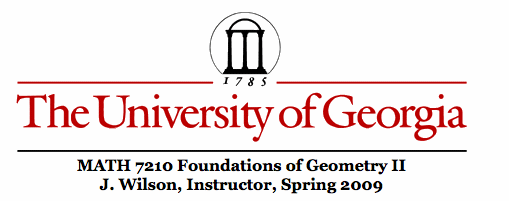

Problem Set 5.3
Problem 5.3.1a. See GSP file from Jackie Ruff
Problem 5.3.1b. See GSP file from Jackie Ruff
Problem 5.3.1c. See GSP file by Allyson Hallman
If all the angles of triangle ABC are acute, prove that the perimeter p of the Pedal Triangle of the Orthocenter (the Orthic Triangle) is given by
p = 4R sin A sin B sin C
where R is the radius of the circumcircle for triangle ABC.
Problem 5.3.1d. See GSP file for this solution.
If all the angles of triangle ABC are acute, prove that the ratio between the perimeters of triangle ABC and the orthic triangle equals the ratio of the circumferences of the circumcircle of triangle ABC and the incircle of triangle ABC.
Let P be the perimeter of P = a + b + c of Triangle ABC.
Let p be the perimeter of p = x + y + z of the orthic triangle.
Let R be the radius of the circumcircle and r the radius of the incircle. The ratio of the radii would be the same as the ratio of the circumferences.
LEMMA --
Prove OA is perpendicular to EF, OB is perpendicular to FD, and OC is perpendicular to DE.
Problem 5.3.2.
Problem 5.3.3.
Problem 5.3.4. See GSP File from Nick Gomez
a. Prove that the three circles are concurrent (intersect at a single point). What is the significance of the point O at which the circles intersect? Justify your answer.
The point O is the same as the Fermat point when the triangle has no angle greater than 120 degrees. It is sometimes called the First (or outer) Fermat Point. The 'outer' label comes from the idea that the equilateral triangle are constructed outward from the sides of the original triangle.
If we assume the Fermat point and its construction, then it follows immediately that point O is the same point. If we are not assuming the prior construction of the Fermat point, then a proof such as Nick and Brian have presented is needed. Usually, when this proof is presented, in addition to showing the three cyclic quadrilaterals, an argument is presented that Points A, O, and G are on the same line.
The proof can be extended for the case when the angle at A is more than 120 degrees. The three circles are concurrent.
Further, the Concurrency holds for the trivial case when point A, is on BC and we have degenerate triangle ABC.
b. Use rotations to prove that the segments joining each vertex of triangle ABC with the remote vertex of the corresponding equilateral constructed on the opposite side of triangle ABC are congruent.
This was done in the discussion document for Sect 5.3.
c. Draw a triangle in which one of the angles is greater than 120 degrees. What happens to the construction in part (a) for this triangle?
The concurrent of the three circles still exists but is outside triangle ABC.
d. Is it possible to construct the Fermat Point for the triangle in Part (c)? Why or why not?
As a point of concurrency of the three circumcircles, the point can be proven to exist. Likewise the proof of the concurrency of LINES (rather than segments) can be extended to the obtuse triangle with an angle of more than 120 degrees. Further the corresponding line SEGMENTS from the outer vertex of the equilateral triangle on a side to the opposite vertex of the triangle are congruent.
The point can be constructed; it is not the solution to Fagnano's Problem.
e. Prove that the centers O1, O2, and O3 of the three circles determine an equilateral triangle.
This is the First (or Outer) Napoleon triangle
See demonstration by Bryant, Maddox, and Nipper
See discussion of Napoleon's Theorem From MathPages
GSP file for this Construction
Construct the equilateral triangles INWARD on the triangle ABC and in the same manner:
1. Prove the three circles are concurrent.
The point of concurrency is the Second (or Inner) Fermat Point
2. Show that the centers of the three INWARD equilateral triangles determine and equilateral triangle.
This is the Second (or INNER) Napoleon Triangle.
NAPOLEON POINTS
Corresponding somewhat to the Fermat points, there are the Napoleon Points. The characterization/construction of the Napoleon Points in Class on April 15 was incomplete or erroneous. All we examined in class were the First Fermat Point (equilateral triangles to the outside) and the Second Fermat Point (equilateral triangles to the inside).
Napoleon points are also points of concurrency. However, the lines determining the concurrency for the First Napoleon point are drawn from the vertex of the given triangle to the center (centroid, circumcenter, ...) of the equilateral triangles constructed externally on the opposite side. The Second Napoleon Point is the analogous point with the equilateral triangles constructed inward.
Prove the concurrency for
a. the First Napoleon Point
b. the Second Napoleon Point
A MORE GENERAL CONCURRENCY THEOREM:
For any triangle ABC, construct SIMILAR ISOSCELES TRIANGLES on the respective sides. Prove that the LINES connecting each vertex of triangle ABC to the corresponding vertex of the similar triangle on the opposite side of the triangle are concurrent.
Consider how to construct this GSP File.
Here is the picture from GSP when the similar triangles are constructed inward.
The power of this more general theorem is that the Centroid, Orthocenter (in the limit), First Fermat Point, Second Fermat Point, First Napoleon Point, and Second Napoleon Point are all special cases of concurrency. Hence establishing concurrency for this more general theorem would prove the concurrency for all of the previous listed -- and others.
Another Equilateral Triangle Theorem -- Sort of like a Napoleon Triangle
Click HERE
Problem 5.3.5 See GSP File from Laura Singletary
Problem 5.3.6
Problem 5.3.7 Check here for a GSP file